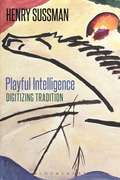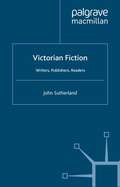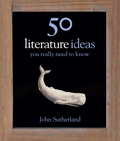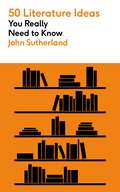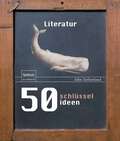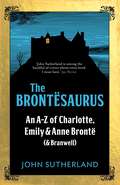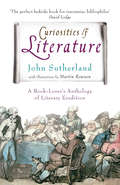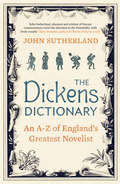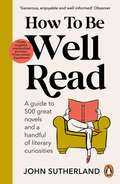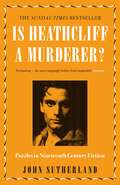- Table View
- List View
The Great Dismissal: Memoir of the Cultural Demolition Derby, 2015-22
by Henry SussmanVeteran scholar and critic Henry Sussman deploys anecdote, reportage, and memoir to lament and scrutinize the rise of anti-intellectualism in the past few decades. How are we to reckon with the decline of impartiality and sharp increase in self-interested interference in politic, legal, and cultural spheres; the normalization of pathological narcissism in public life; and the blanket dismissal of scientific findings and their counterparts in the humanities and social sciences?In retracing his own intellectual and experiential steps, Sussman revisits many of his lasting inspirations, including Walter Benjamin, Jacques Derrida, Douglas R. Hofstadter, Immanuel Kant, and J. Hillis Miller. The result is an intellectual meditation on 'the great dismissal,' in public and political life, of venerable and vital humanistic traditions, ethics, and ways of thinking.
Playful Intelligence: Digitizing Tradition
by Henry SussmanThis is a guide, in theory and in practice, to how current technological changes have impacted our interaction with texts and with each other. Henry Sussman rereads pivotal moments in literary, philosophical and cultural modernity as anticipating the cybernetic discourse that has increasingly defined theory since the computer revolution. Cognitive science, psychoanalysis and systems theory are paralleled to current trends in literary and philosophical theory.Chapters alternate between theory and readings of literary texts, resulting in a broad but rigorously grounded framework for the relation between literature and computer science. This book is a refreshing perspective on the analog-orientated tradition of theory in the humanities – and offers the first literary-textual genealogy of the digital.
Playful Intelligence: Digitizing Tradition
by Henry SussmanThis is a guide, in theory and in practice, to how current technological changes have impacted our interaction with texts and with each other. Henry Sussman rereads pivotal moments in literary, philosophical and cultural modernity as anticipating the cybernetic discourse that has increasingly defined theory since the computer revolution. Cognitive science, psychoanalysis and systems theory are paralleled to current trends in literary and philosophical theory.Chapters alternate between theory and readings of literary texts, resulting in a broad but rigorously grounded framework for the relation between literature and computer science. This book is a refreshing perspective on the analog-orientated tradition of theory in the humanities – and offers the first literary-textual genealogy of the digital.
High Resolution: Critical Theory And The Problem Of Literacy
by Henry S. SussmanAt the heart of this important new book is the tension between literacy and the open acknowledgement of discrepancies within social and linguistic fields on the one hand, and what Sussman terms the resolving function, the utopian picture of harmony depicted by the state and large organizations, on the other. After discussing some examples of the resolving function--Barthes's notion of the myth, Kundera's fictional treatment of kitsch, and contemporary television--Sussman draws on a line of theoretical inquiry extending from Saussure to Derrida in order to put forth a differential model of literacy in which the skills necessary to participate productively in culture are more disjunctive than associative in nature. Awareness of the discrepancies set into play by language is necessary, he argues, for both the individual and the society to understand the complex and sometimes contradictory web of socioeconomic, political, and semiological relations in which they are involved. Combining literary theory with close textual readings of works by Hawthorne, Melville, Wallace Stevens, Ezra Pound, William Carlos Williams, and Italo Calvino, this book is the first to explore the socio-political correlatives to literary studies--the mass media's ambivalence toward the linguistic apprehensions and skills that make them possible.
High Resolution: Critical Theory and the Problem of Literacy
by Henry S. SussmanAt the heart of this important new book is the tension between literacy and the open acknowledgement of discrepancies within social and linguistic fields on the one hand, and what Sussman terms the resolving function, the utopian picture of harmony depicted by the state and large organizations, on the other. After discussing some examples of the resolving function--Barthes's notion of the myth, Kundera's fictional treatment of kitsch, and contemporary television--Sussman draws on a line of theoretical inquiry extending from Saussure to Derrida in order to put forth a differential model of literacy in which the skills necessary to participate productively in culture are more disjunctive than associative in nature. Awareness of the discrepancies set into play by language is necessary, he argues, for both the individual and the society to understand the complex and sometimes contradictory web of socioeconomic, political, and semiological relations in which they are involved. Combining literary theory with close textual readings of works by Hawthorne, Melville, Wallace Stevens, Ezra Pound, William Carlos Williams, and Italo Calvino, this book is the first to explore the socio-political correlatives to literary studies--the mass media's ambivalence toward the linguistic apprehensions and skills that make them possible.
History, Memory and Public Life: The Past in the Present
by Adam Sutcliffe Anna Maerker Simon SleightHistory, Memory and Public Life introduces readers to key themes in the study of historical memory and its significance by considering the role of historical expertise and understanding in contemporary public reflection on the past. Divided into two parts, the book addresses both the theoretical and applied aspects of historical memory studies. ‘Approaches to history and memory‘ introduces key methodological and theoretical issues within the field, such as postcolonialism, sites of memory, myths of national origins, and questions raised by memorialisation and museum presentation. ‘Difficult pasts‘ looks at history and memory in practice through a range of case studies on contested, complex or traumatic memories, including the Northern Ireland Troubles, post-apartheid South Africa and the Holocaust. Examining the intersection between history and memory from a wide range of perspectives, and supported by guidance on further reading and online resources, this book is ideal for students of history as well as those working within the broad interdisciplinary field of memory studies.
History, Memory and Public Life: The Past in the Present
by Adam Sutcliffe Anna Maerker Simon SleightHistory, Memory and Public Life introduces readers to key themes in the study of historical memory and its significance by considering the role of historical expertise and understanding in contemporary public reflection on the past. Divided into two parts, the book addresses both the theoretical and applied aspects of historical memory studies. ‘Approaches to history and memory‘ introduces key methodological and theoretical issues within the field, such as postcolonialism, sites of memory, myths of national origins, and questions raised by memorialisation and museum presentation. ‘Difficult pasts‘ looks at history and memory in practice through a range of case studies on contested, complex or traumatic memories, including the Northern Ireland Troubles, post-apartheid South Africa and the Holocaust. Examining the intersection between history and memory from a wide range of perspectives, and supported by guidance on further reading and online resources, this book is ideal for students of history as well as those working within the broad interdisciplinary field of memory studies.
Inklusiver aufgabenorientierter Englischunterricht: Kooperative Entwicklung und Erprobung eines Unterrichtsmodells in der Praxis (Literatur-, Kultur- und Sprachvermittlung: LiKuS)
by Christoph SuterGemeinsames Englischlernen in einer bunt gemischten Lerngruppe ist möglich. Ein im Schulalltag umsetzbares, gemeinsam entwickeltes und erprobtes Unterrichts- und Unterstützungskonzept, das die Arbeit mit Lernaufgaben ins Zentrum stellt, lässt Forschung, Lehrpersonen und Lernende gemeinsam Entwicklungsschritte gehen. So kommen eine solide, empirisch abgestützte theoretische Grundlage und die Bedingungen der Unterrichtspraxis zusammen, um Perspektiven für inklusive Unterrichtentwicklung zu eröffnen.
Women’s Manga in Asia and Beyond: Uniting Different Cultures and Identities (Palgrave Studies in Comics and Graphic Novels)
by Rebecca Suter John A. Lent Kazumi Nagaike Fusami OgiWomen’s Manga in Asia and Beyond offers a variety of perspectives on women’s manga and the nature, scope, and significance of the relationship between women and comics/manga, both globally as well as locally. Based on the activities since 2009 of the Women’s MANGA Research Project in Asia (WMRPA), the edited volume elucidates social and historical aspects of the Asian wave of manga from ever-broader perspectives of transnationalization and glocalization. With a specific focus on women’s direct roles in manga creation, it illustrates how the globalization of manga has united different cultures and identities, focusing on networks of women creators and readerships. Taking an Asian regional approach combined with investigations of non-Asian cultures which have felt manga’s impact, the book details manga’s shift to a global medium, developing, uniting, and involving increasing numbers of participants worldwide. Unveiling diverse Asian identities and showing ways to unite them, the contributors to this volume recognize the overlaps and unique trends that emerge as a result.
Victorian Fiction: Writers, Publishers, Readers
by J. SutherlandDrawing on extensive research, John Sutherland builds up a fascinating picture of the cultural, social and commercial factors influencing the content and production of Victorian fiction, discussing major writers such as Collins, Dickens, Eliot, Thackeray and Trollope alongside writers also very popular with the reading public - Reade, Lytton and Mrs Humphry Ward - but whose fame has not endured. Richly informative on the Victorian literary and cultural scene, this new reissue of John Sutherland's important 1995 study is essential reading for all those interested in the evolution of the Victorian novel, and includes a new Preface situating the book in current research being carried out on the history of the book and print culture.
Fiction and the Fiction Industry (Bloomsbury Academic Collections: English Literary Criticism)
by J. A. SutherlandThis topical, lively and wide-ranging book examines the material conditions under which the contemporary English novel is produced and consumed. Its starting point is the general economic emergency which showed up these conditions with unusual clarity in the early 1970s. The first section of the book, 'Crisis and Change', considers the changing patterns of institutional book-purchase, inflation and novel-production, the 'Americanisation' of the British book trade, and the present state of fiction reviewing. The second section, 'State Remedies', surveys such interventions, and failed interventions, as Public Lending Right, Arts Council patronage, and university support for creative writers. The third section, 'Trends, Mainly American', selects specific areas (paperback publishing, self-publishing, book-clubs, television work) which offer pointers to significant future developments in British literary culture. Fiction and the Fiction Industry pays close attention to actual novels, combining literary criticism with its examination of the book trade.
Thackeray at Work (Bloomsbury Academic Collections: English Literary Criticism)
by J. A. SutherlandThe study of Thackeray's major fiction reconstructs the novelist's working methods with the help of manuscript material, much of it previously unpublished. The book's main argument is directed against the commonplace view that Thackeray was in some way a 'careless' artist. Much that appears casual or unpremeditated in his work can in fact be explained by the mode of composition which he developed in response both to the publishing conditions of his age and to his own artistic temperament. An appreciation of Thackeray's writing habits helps clear up much of the critical confusion which has surrounded his reputation in the last hundred years. A particular feature of interest in the book is the use made of Thackeray's preparatory working materials. These were widely dispersed after the writer's death and have never been comprehensively examined.
Victorian Novelists and Publishers (Bloomsbury Academic Collections: English Literary Criticism)
by J. A. SutherlandIntroduction Part One: The Novel Publishing World, 1830-18701. Novel Publishing 1830-18702. Mass Market and Big Business: Novel Publishing at Midcentury3. Craft versus Trade: Novelists and PublishersPart Two: Novelists, Novels and their Publishers, 1830-18704. Henry Esmond: The Shaping Power of Contract5. Westward Ho!: 'A Popularly Successful Book' 6. Trollope: Making the First Rank7. Lever and Ainsworth: Missing the First Rank8. Dickens as Publisher9. Marketing Middlemarch10. Hardy: Breaking into FictionNotesIndex
50 Literature Ideas You Really Need to Know (50 Ideas You Really Need to Know series)
by John SutherlandLiterature suffers from appearing both deceptively easy and dauntingly difficult. We all like to think we can read a novel and understand what 'genre', 'style' and 'narrative' mean, but do we really understand them fully and how they can enrich our reading experience? How should we approach the works of great writers such as William Shakespeare, T.S. Eliot, Charles Dickens and Jane Austen? 50 Literature Ideas you Really Need to Know provides a clear, opinionated and thorough overview of literary theories from the apparently familiar to the decidedly unfamiliar. Packed with insights and examples from both classic and popular works, it is a book that will delight anyone who has ever been mystified by literary jargon and wants to gain a deeper enjoyment of reading and writing.
50 Literature Ideas You Really Need to Know (50 Ideas You Really Need to Know series)
by John SutherlandIn a series of 50 accessible essays, John Sutherland introduces and explains the important forms, concepts, themes and movements in literature, drawing on insights and examples from both classic and popular works.From postmodernism to postcolonialism, William Shakespeare to Jane Austen , 50 Literature Ideas You Really Need to Know is a complete introduction to the most important literary concepts in history.
50 Schlüsselideen Literatur
by John Sutherland50 Schlüsselideen Literatur ist eine grundlegende Einführung in alle wichtigen Formen, Begriffe, Themen und Strömungen der Literatur. Der erfolgreiche Autor und Literaturkritiker John Sutherland stellt Literaturkonzepte und -theorien auf frische und zugleich anspruchsvolle Weise vor – von scheinbar vertrautem Terrain bis hin zu unbekannten Gefilden. Randvoll mit klugen Einblicken und Zitaten aus klassischen wie aus populären Werken, zieht dieses Buch alle in seinen Bann, die jemals fragend vor dem Fachjargon der Literaturkritik standen und die das Lesen und Schreiben auf eine tiefere und bewusstere Weise genießen möchten.
The Brontesaurus: An A–Z of Charlotte, Emily and Anne Brontë (and Branwell)
by John SutherlandDid Charlotte Brontë take opium? Did the Reverend Brontë carry a loaded pistol? What, precisely, does ‘wuthering’ mean? Distinguished literary critic John Sutherland takes an idiosyncratic look at the world of the Brontës, from the bumps on Charlotte’s head to the nefarious origins of Mr Rochester’s fortune, by way of astral telephony, letterwriting dogs, an exploding peat bog, and much, much more. Also features ‘Jane Eyre abbreviated’ by John Crace, author of the Guardian’s ‘Digested Reads’ column – read Charlotte Brontë’s masterpiece in five minutes!
Can Jane Eyre Be Happy?: More Puzzles in Classic Fiction (Oxford World's Classics Ser.)
by John Sutherland'Wonderful...concise, witty, effortlessly learned.' Sunday Times How does Magwitch swim to shore with a great iron on his leg? Where does Fanny Hill keep her contraceptives? Whose side is Hawkeye on? And how does Clarissa Dalloway get home so quickly? In this new edition sequel to the enormously successful Is Heathcliff a Murderer?, John Sutherland plays literary detective and investigates 32 literary conundrums, ranging from Daniel Defoe to Virginia Woolf. As in its universally loved predecessor, the questions and answers are ingenious and convincing, and return the reader with new respect to the great novels that inspire them.
Curiosities of Literature: A Book-lover's Anthology of Literary Erudition
by John SutherlandHow much heavier was Thackeray's brain than Walt Whitman's? Which novels do American soldiers read? When did cigarettes start making an appearance in English literature? And, while we're about it, who wrote the first Western, is there any link between asthma and literary genius, and what really happened on Dorothea's wedding night in Middlemarch?In Curiosities of Literature, John Sutherland contemplates the full import of questions such as these, and attempts a few answers in a series of essays that are both witty and eclectic. His approach is also unashamedly discursive. An account of the fast-working Mickey Spillane, for example, leads to a consideration of the substances, both legal and illegal, that authors have employed to boost their creative energies. An essay on good and bad handwriting points out in passing that Thackeray could write the Lord's Prayer on the back of a stamp. As for Mary Shelley, a brief recital of the circumstances in which she wrote Frankenstein stops off to consider what impact the miserable summer weather of 1816 had on the future path of English literature. Of course, it is debatable whether knowledge of these arcane topics adds to the wisdom of nations, but it does highlight the random pleasures to be found in reading literature and reading about it. As John Sutherland rightly asks, 'Why else read?'
The Dickens Dictionary: An A-Z of Britain's Greatest Novelist
by John SutherlandFor fans new and old, an enjoyable tour through the world of Dickens in the hands of a master critic. Charles Dickens, the 'Great Inimitable', created a riotous fictional world that still lives and breathes for thousands of readers today. But how much do we really know about the dazzling imagination that brought all this into being? For the bicentenary of Dickens' birth, Victorian literature expert John Sutherland has created a gloriously wide-ranging alphabetical companion to Dickens' work, excavating the hidden links between his characters, themes, and preoccupations, and the minutiae of his endlessly inventive wordplay. Covering America, Bastards, Childhood, Christmas, Empire, Fog, Larks, London, Madness, Murder, Orphans, Pubs, Punishment, Smells, Spontaneous Combustion and Zoo to name but a few - John Sutherland gives us a uniquely personal guide to the great man's work. Excerpt: HANDS; Every Dickens novel has a master image. In Our Mutual Friend it is the river. In Bleak House it is the fog. In Little Dorrit, it is the prison. In Great Expectations it is the hand. We often know much more about the principals' hands in that novel than their faces. Who, when the name Magwitch is mentioned, does not think of those murderous 'large brown veinous hands'? Jaggers? One's nose twitches---scented soap (the lawyer, like Pontius Pilate, is forever washing his hands). Miss Havisham? Withered claws. So it goes on...
Frankenstein’s Brain: Puzzles and Conundrums in Mary Shelley’s Monstrous Masterpiece
by John Sutherland200 years on from the first publication of Frankenstein, John Sutherland delves into the deepest, darkest corners of Mary Shelley’s gothic masterpiece to see what strange and terrifying secrets lie within. Is Victor Frankenstein a member of the Illuminati? Was Mary Shelley really inspired by spaghetti? Whoever heard of a vegan monster? Exploring the lesser-known byways of both the original tale and its myriad film and pop culture spinoffs, from the bolts on Boris Karloff’s neck to the role of Igor in Young Frankenstein, Frankenstein’s Brain is a fascinating journey behind the scenes of this seminal work of literature and imagination. Includes a unique digest by the Guardian’s John Crace.
How to be Well Read: A guide to 500 great novels and a handful of literary curiosities
by John SutherlandAs the annual flood of published novels grows ever greater, it’s a hard a job to keep up, let alone sort the wheat from the chaff. Fortunately, literary sleuth and academic John Sutherland is on hand to do precisely that. In the course of over 500 wittily informative pieces he gives us his own very personal take on the most rewarding, most remarkable and, on occasion, most shamelessly enjoyable works of fiction ever written – the perfect reading list for the would-be literary expert. His taste is impressively eclectic. An appreciation of Apuleius’s The Golden Ass – arguably the first-ever novel – is followed by a consideration of Ian Fleming’s Goldfinger. The Handmaid’s Tale is followed by Hangover Square, Jane Eyre by Jaws. There are imposing Victorian novels, entertaining contemporary thrillers and everything in between, from dystopian works to romance.The flavour of each is brilliantly evoked and its relative merits or demerits assessed. At the same time, John Sutherland shows how the work fits into a broader context – whether that of the author’s life or of other books from the same genre or period. And he offers endless snippets of intriguing information: did you know, for example, that the Nazis banned Bambi or that William Faulkner wrote As I Lay Dying on an upturned wheelbarrow; that Voltaire completed Candide in three days, or that Anna Sewell was paid £20 for Black Beauty? Encyclopedic and entertaining by turns, this is a wonderful dip-in book, whose opinions will inform and on occasion, no doubt, infuriate. It is also effectively a history of the novel in 500 or so bite-sized pieces.
Is Heathcliff a Murderer?: Puzzles in Nineteenth-Century Fiction (Oxford World's Classics Ser.)
by John SutherlandTHE SUNDAY TIMES BESTSELLER IN A BRAND NEW EDITION 'Enchanting...the most engagingly boffiny book imaginable.' Spectator Does Becky kill Jos at the end of Vanity Fair? Why does no one notice that Hetty is pregnant in Adam Bede? How, exactly, does Victor Frankenstein make his monster? Readers of Victorian fiction often find themselves tripping up on seeming anomalies, enigmas and mysteries in their favourite novels. In Is Heathcliff a Murderer? John Sutherland investigates 34 conundrums of nineteenth-century fiction, paying homage to the most rewarding of critical activities: close reading and the pleasures of good-natured pedantry
The Longman Companion to Victorian Fiction
by John SutherlandWith over 900 biographical entries, more than 600 novels synopsized, and a wealth of background material on the publishers, reviewers and readers of the age the Longman Companion to Victorian Fiction is the fullest account of the period's fiction ever published. Now in a second edition, the book has been revised and a generous selection of images have been chosen to illustrate various aspects of Victorian publishing, writing, and reading life. Organised alphabetically, the information provided will be a boon to students, researchers and all lovers of reading. The entries, though concise, meet the high standards demanded by modern scholarship. The writing - marked by Sutherland's characteristic combination of flair, clarity and erudition - is of such a high standard that the book is a joy to read, as well as a definitive work of reference.
The Longman Companion to Victorian Fiction
by John SutherlandWith over 900 biographical entries, more than 600 novels synopsized, and a wealth of background material on the publishers, reviewers and readers of the age the Longman Companion to Victorian Fiction is the fullest account of the period's fiction ever published. Now in a second edition, the book has been revised and a generous selection of images have been chosen to illustrate various aspects of Victorian publishing, writing, and reading life. Organised alphabetically, the information provided will be a boon to students, researchers and all lovers of reading. The entries, though concise, meet the high standards demanded by modern scholarship. The writing - marked by Sutherland's characteristic combination of flair, clarity and erudition - is of such a high standard that the book is a joy to read, as well as a definitive work of reference.

